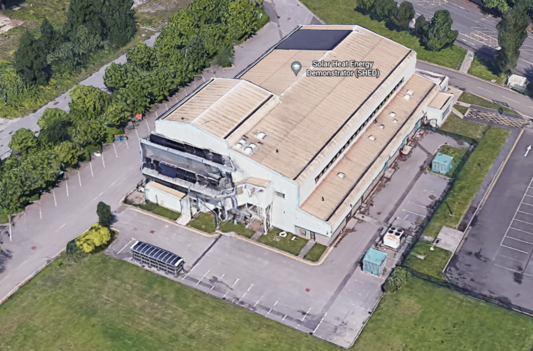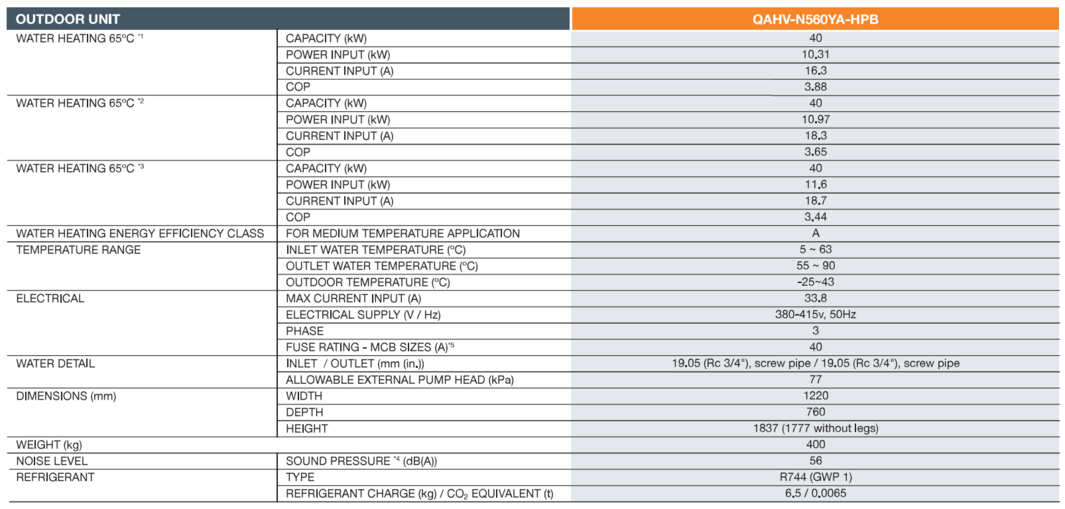Difference between revisions of "Solar Heat Energy Demonstrator"
| Line 10: | Line 10: | ||
== Heat Pump Selection == | == Heat Pump Selection == | ||
[[File:Qavh.png|thumb|Mitsubishi Electric QAVG 40kW CO2 Air Source Heat Pump]]<blockquote>Specifically designed for commercial sanitary hot water application, where gas boilers, combined heat and power systems (CHP) or electric water heating have been traditionally utilised, the QAHV provides a low carbon solution for hospitals, hotels, leisure centres and student accommodation. Utilising the natural and stable refrigerant CO2 (R744), the environmentally clean solution enables compliance to strict local planning laws and boosts BREEAM points. Compounded by the increasing decarbonisation of the electrical grid and the UK’s commitment to Net Zero 2050, the QAHV provides a high efficiency, low carbon hot water delivery solution with leaving water temperature up to 90°C.</blockquote>{{#l:QAHV_6PP_AW_v2.pdf}}<br> | [[File:Qavh.png|thumb|Mitsubishi Electric QAVG 40kW CO2 Air Source Heat Pump]]The selected heat pump is a Mitsubishi Electric QAVG 40kW CO2 Air Source Heat Pump.<blockquote>''Specifically designed for commercial sanitary hot water application, where gas boilers, combined heat and power systems (CHP) or electric water heating have been traditionally utilised, the QAHV provides a low carbon solution for hospitals, hotels, leisure centres and student accommodation. Utilising the natural and stable refrigerant CO2 (R744), the environmentally clean solution enables compliance to strict local planning laws and boosts BREEAM points. Compounded by the increasing decarbonisation of the electrical grid and the UK’s commitment to Net Zero 2050, the QAHV provides a high efficiency, low carbon hot water delivery solution with leaving water temperature up to 90°C.''</blockquote>{{#l:QAHV_6PP_AW_v2.pdf}}<br> | ||
{{#l:QAHV-N560YA-HPB_Service_Manual.pdf}}<br> | {{#l:QAHV-N560YA-HPB_Service_Manual.pdf}}<br> | ||
{{#l:QAHV-N560YA-HPB_Install_Manual.pdf}}<br> | {{#l:QAHV-N560YA-HPB_Install_Manual.pdf}}<br> | ||
Revision as of 00:35, 11 June 2022
To Do:
- Review designs and calculate loads
- Produce schematic of proposed design
- Detailed design of pipework and equipment
Site Information
Heat Pump Selection
The selected heat pump is a Mitsubishi Electric QAVG 40kW CO2 Air Source Heat Pump.
Specifically designed for commercial sanitary hot water application, where gas boilers, combined heat and power systems (CHP) or electric water heating have been traditionally utilised, the QAHV provides a low carbon solution for hospitals, hotels, leisure centres and student accommodation. Utilising the natural and stable refrigerant CO2 (R744), the environmentally clean solution enables compliance to strict local planning laws and boosts BREEAM points. Compounded by the increasing decarbonisation of the electrical grid and the UK’s commitment to Net Zero 2050, the QAHV provides a high efficiency, low carbon hot water delivery solution with leaving water temperature up to 90°C.
![]() QAHV-N560YA-HPB_Service_Manual
QAHV-N560YA-HPB_Service_Manual
![]() QAHV-N560YA-HPB_Install_Manual
QAHV-N560YA-HPB_Install_Manual
![]() QAHV-N560YA-HPB-PI-SHEET
QAHV-N560YA-HPB-PI-SHEET
Sizing
Bivalent Systems for Heat Networks
The following designs show the impact of a single 40kW heat pump on various numbers of properties. This is unrelated to the SHED, however is shown in order to give the reader a feel for the impact of even a single heat pump on real-world loads.
Each property is 2 bedroom 3 person, and 4kW heating load.
Topping up boilers are included to achieve peak loads.
| Properties | % Heat Pump | Design Link |
|---|---|---|
| 20 x 2B3P | 99.9% | https://hw7.ddns.net/ui/hndesign?loadCID=QmNg4trTmoxkD35qj4eBWd1exKwKfbVpP3jRNgEQwZn4qB |
| 30 x 2B3P | 94.6% | https://hw7.ddns.net/ui/hndesign?loadCID=QmXz5H1sdV5F1juQrQc71PLjdWCPWkHhqHkitGbC8o8B9z |
| 40 x 2B3P | 83.6% | https://hw7.ddns.net/ui/hndesign?loadCID=QmPgBB6jSXehwP2ZYp7LcZNQeEyXggQM4FPgcgdQWQgZVc |
This graph shows how the vast majority of load (for 2021) is driven by heat pumps (blue & orange), with boilers (green) used to top up.



